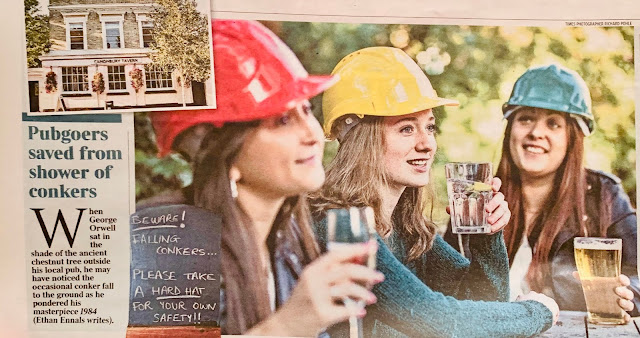Bullard’s first hard hat was called the Hard Boiled hat. It was made of steamed canvas and leather (metal was too expensive), wascovered with black paint and featured a suspension system. Orders surged in the 1930s when engineers building the Golden Gate Bridge required workers to wear Bullard hard hats, which were upgraded to protect against falling rivets. Standard hard hat design has evolved over the years, from canvas to metal to fiberglass and, eventually, to plastic.
In 1970, Congress passed the Occupational Safety and Health Act, creating the Occupational Safety and Health Administration, which required that hard hats be used on many job sites.
As the industry grew, Bullard faced more competition, from companies like Honeywell, Kask, MSA Safety and 3M.
Over the years, the popularity of hard hats surged beyond safety requirement to status symbol, said Beth Rosenberg, an associate professor at Tufts University School of Medicine.
During Boston’s
Big Dig construction project, she wondered why construction workers were not wearing respirators and hearing protection where it would have been advisable, even though nearly everyone on the $24 billion project wore a hard hat. Compliance was so high that even those not required to wear hard hats donned them. This prompted her and a colleague to research the social history of hard hats for a
2010 paper.
Dr. Rosenberg said hard hats had become associated with masculinity and patriotism. “There was a confluence of social factors that made hard hats cool that has not happened with hearing protection or respirators,” she said.
The term “hard hats” even became shorthand for working people with a conservative patriotism, and New York tabloid reporters still use the term to denote construction workers.
Bullard said it did not make gender-specific hard hats, but acknowledged that women were a fast-growing part of the construction industry. In 2016, 9 percent of construction workers in the United States
were women, according to a report from the National Association of Women in Construction.
Over the years, hard hats have prevented injuries in a wide range of workplaces.
William Ross Aiken, an electrical engineer who became a pioneer in TV technology, recalled the close call he had while working in a shipyard during World War II. “I was saved by my hard hat once when some metal fell 60 feet from a gantry crane and hit me on the head,” he said in a 1996 oral history for the Institute of Electrical and Electronics Engineers. “It made a big dent in my aluminum hat, but it saved my life.”Didier Bonner-Ganter, an arborist in Maine, does not remember being hit by a tree while working on a logging crew during his college years, but does remember standing in the forest with a sore shoulder, and his hard hat on the ground next to him, newly cracked. He does not know what would have happened to him if he had not been wearing a hard hat, but said, “It certainly would have been worse.”
Scott Storace was a project manager on a residential high-rise in San Francisco when a worker dropped a metal scaffolding coupler from six floors up.“The hard hat did its trick,” he said. “It’s got that little bit of room between where it sits on your head and where the hard plastic is, and that cushioned the blow.”
Ms. Bullard, the company chief, said she heard a lot of stories like these.
She said her great-grandfather would still recognize the hard hats the company produced today.
“The technology of the hard hat really hasn’t changed so dramatically in 100 years,” she said. “There’s a suspension, and there’s a shell.”
But changes are coming. Ms. Bullard said her company’s products were evolving not only to protect workers from falling objects, but also to protect them when the workers were the falling objects.
Early next year, Bullard will introduce a new line of hard hats with foam padding and integrated chin straps, similar to climbing helmets, but designed for industrial workers, and with their input.
“Head protection reinvented,” Ms. Bullard said. “One hundred years ago, we invented it, and now we’re reinventing it.”
Falls are the No. 1 killer on construction sites, said G. Scott Earnestof the National Institute for Occupational Safety and Health. A 2016 report from the agency found that more than 2,200 construction workers died from traumatic brain injuries from 2003 to 2010.
Dr. Earnest said he believed redesigned hard hats could better protect falling workers.
“The next generation, the ones that are just starting to be seen on construction sites, are a lot more like a helmet a mountain climber might wear, or a hockey player, or a kid on a bicycle,” he said. “Anything we can do to provide better protection for construction workers is important, because it’s a very hazardous industry.”



















































